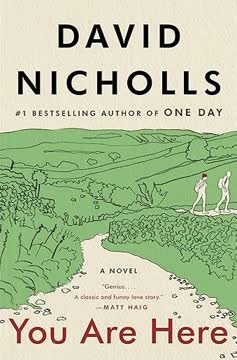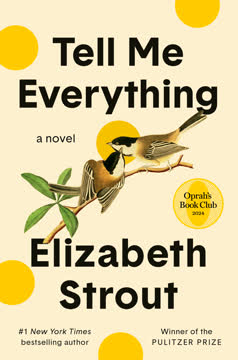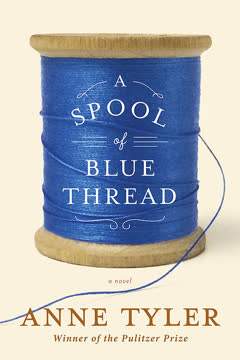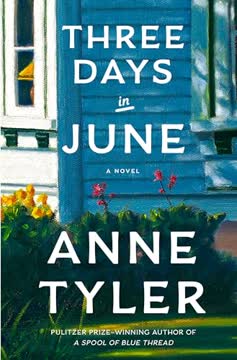Plot Summary
Tree Falls, Life Shatters
Aaron Woolcott's life is irrevocably changed when a massive oak tree crashes through his house, killing his wife, Dorothy. The accident is sudden, senseless, and leaves Aaron physically unscathed but emotionally devastated. The chaos of the event—rescue workers, neighbors, and the surreal aftermath—sets the tone for Aaron's journey through grief. He is forced to leave his ruined home and move in with his sister, Nandina, beginning a period of dislocation and numbness. The randomness of the tragedy haunts him, and the loss of Dorothy feels both unreal and all-consuming, as if he's been erased along with her.
Ghosts in Broad Daylight
Months after Dorothy's death, Aaron begins to see her—on the street, at the market, beside him in everyday places. These encounters are not dramatic hauntings but quiet, matter-of-fact appearances that only he seems to notice. Dorothy's presence is both comforting and disconcerting, blurring the line between memory and reality. Aaron is unsure if she's a ghost, a hallucination, or a figment of his longing, but her visits become a lifeline. The world around him reacts awkwardly or not at all, highlighting his isolation in grief and the strangeness of carrying on with the dead so near.
The Beginner's Grief
Aaron's grief is raw, awkward, and unheroic. He struggles with the rituals of mourning—sympathy casseroles, condolence notes, and the well-meaning but clumsy support of friends and neighbors. He finds little solace in these gestures, often dumping food straight into the trash and answering letters with mechanical politeness. The routines of daily life become both a burden and a distraction. Aaron's work at his family's publishing company, especially editing the "Beginner's" series, becomes a metaphor for his own search for a manual on how to survive loss.
Family Ties, Frayed Edges
Living with Nandina, Aaron is thrust back into childhood dynamics. Nandina is practical, bossy, and well-intentioned, but her efforts to help often chafe. Their shared history—marked by their mother's overprotectiveness and Aaron's childhood illness—colors their interactions. Nandina's own loneliness and quirks come to the fore, and Aaron's dependence on her is both comforting and suffocating. The siblings' relationship is a mix of affection, irritation, and mutual incomprehension, revealing how family can both support and stifle in times of crisis.
The Unfinished Goodbye
As Dorothy continues to appear, Aaron becomes obsessed with understanding why she's come back. Is she here to deliver a message, or is it his own inability to let go that keeps her near? Their conversations—real or imagined—circle around unresolved issues in their marriage: misunderstandings, unmet needs, and the things left unsaid. Dorothy's matter-of-fact demeanor in death mirrors her personality in life, and Aaron is forced to confront the reality that their relationship was far from perfect. The process of saying goodbye becomes a negotiation between memory, regret, and acceptance.
Rebuilding, Remembering, Regretting
With the help of contractor Gil Bryan, Aaron begins the slow process of repairing his damaged home. The reconstruction is both literal and symbolic—a chance to rebuild his life, but also a confrontation with the memories embedded in every room. Sorting through Dorothy's belongings, Aaron is flooded with recollections, both sweet and painful. The house becomes a site of both mourning and renewal, and the workmen's presence is a reminder that life, in all its messiness, goes on.
Love's Awkward Beginnings
Flashbacks reveal how Aaron and Dorothy met and fell in love. Their relationship is marked by awkwardness, mismatched expectations, and a lack of traditional romance. Dorothy is blunt, practical, and uninterested in social niceties; Aaron is self-conscious, sensitive, and yearning for connection. Their bond grows not from grand gestures but from small acts of acceptance and mutual need. The early days of their marriage are filled with hope and the sense of a fresh start, but also the seeds of future misunderstandings.
Marriage: Not Quite Perfect
As Aaron reflects on his marriage, he acknowledges its imperfections. He and Dorothy were often out of sync—miscommunicating, disappointing each other, and failing to meet unspoken needs. Their differences, once endearing, became sources of friction. Yet, beneath the surface, there was a deep, if flawed, love. Aaron's memories are tinged with regret for the ways they failed each other, but also gratitude for the ordinary, everyday intimacy they shared. The marriage was neither a fairy tale nor a tragedy, but something messier and more real.
The Return of Dorothy
Dorothy's appearances become less frequent but more meaningful. Each visit forces Aaron to confront a different aspect of their relationship—his defensiveness, her emotional reserve, their mutual misunderstandings. These encounters are not about closure in the conventional sense, but about learning to live with ambiguity and imperfection. Dorothy's presence is both a comfort and a challenge, pushing Aaron to reconsider what it means to love, to grieve, and to move forward.
Searching for Meaning
Aaron seeks explanations for Dorothy's return, questioning friends, family, and even himself. Is she a ghost, a projection of his longing, or simply a manifestation of unfinished business? Conversations with others—his contractor Gil, his friend Nate, and his neighbor Mimi—offer different perspectives on loss and the ways the dead linger in the lives of the living. Aaron comes to realize that the answers may not matter as much as the process of paying attention, remembering, and learning from the past.
Letting Go, Moving On
Gradually, Dorothy's visits cease. Aaron recognizes that holding on too tightly to the past prevents him from embracing the present. He begins to reengage with the world—returning to his restored home, reconnecting with friends, and opening himself to new relationships. The process of letting go is not about forgetting, but about making space for new beginnings. Aaron's journey through grief is not linear or complete, but he learns to live with loss as part of life.
New Beginnings, Old Lessons
As Aaron moves forward, he finds companionship with Peggy, his longtime coworker. Their relationship is tentative, gentle, and rooted in shared history and mutual care. The lessons of his marriage to Dorothy—about communication, acceptance, and the importance of small kindnesses—inform his new life. The presence of a child, Maeve, symbolizes hope and the continuity of love. Aaron's story becomes one of renewal, not by erasing the past, but by integrating its lessons into the future.
The Company of the Living
The narrative widens to include the lives of those around Aaron—Nandina's romance with Gil, the daily dramas of the office, the quirks of neighbors and friends. These relationships are imperfect, sometimes frustrating, but ultimately sustaining. The world is full of people muddling through, making mistakes, and trying to do their best. Aaron learns that healing comes not from grand gestures or perfect understanding, but from the ongoing, imperfect company of the living.
The Weight of Memory
Memory is both a burden and a gift. Aaron is haunted by regrets and what-ifs, but also comforted by the recollection of ordinary moments with Dorothy. The process of sorting through belongings, photos, and stories is a way of honoring the past without being trapped by it. The narrative suggests that memory is not static but evolves, allowing for forgiveness, understanding, and growth.
The Beginner's Guide to Goodbye
The title's meaning becomes clear: there is no manual for grief, no expert way to say goodbye. Aaron's journey is that of a beginner—fumbling, uncertain, and often resistant. The process of letting go is ongoing, requiring humility, patience, and the willingness to start over. The story offers no easy answers, but affirms the value of persistence, attention, and the courage to keep living.
The Gift of Presence
Ultimately, the greatest gift we can offer each other is presence—showing up, listening, and sharing the ordinary moments of life. Dorothy's posthumous visits are less about supernatural intervention than about the enduring impact of love and attention. Aaron learns to be present for those around him, and to accept the presence of others in his own life, however imperfectly.
The World Goes On
The world does not pause for grief. Children grow, seasons change, and new challenges arise. Aaron's story is set against the backdrop of everyday life—work, family, community—which continues regardless of personal tragedy. The narrative affirms the resilience of the human spirit and the possibility of joy, even after profound loss.
Love, Loss, and Life
In the end, Aaron's journey is one of acceptance—of himself, of Dorothy, and of the messy, unpredictable nature of life. Love is not perfect, nor is grief ever fully resolved. But by paying attention, forgiving himself and others, and remaining open to new beginnings, Aaron finds a way to say goodbye and to begin again.
Characters
Aaron Woolcott
Aaron is the protagonist, a man marked by physical disability from childhood and emotional vulnerability throughout his life. His right side is weakened, and he stammers under stress, making him self-conscious and sensitive to the perceptions of others. Aaron's relationships are shaped by his mother's and sister's overprotectiveness, leading him to value independence and resist being cared for. His marriage to Dorothy is both a refuge and a source of frustration, as their differences create both intimacy and distance. After Dorothy's death, Aaron is adrift, haunted by regret and longing. His journey through grief is marked by confusion, denial, and gradual acceptance. Aaron's psychological arc moves from isolation and self-pity to a tentative reengagement with life, learning to accept imperfection in himself and others.
Dorothy Rosales
Dorothy is Aaron's late wife, a radiologist of Mexican heritage, older and shorter than Aaron, with a no-nonsense approach to life. She is serious, competent, and uninterested in social conventions or domesticity. Dorothy's emotional reserve and focus on work often frustrate Aaron, but her steadiness and lack of fuss are also what draw him to her. In death, she appears to Aaron in matter-of-fact, unsentimental ways, prompting him to confront the realities of their marriage and his own shortcomings. Dorothy's character is defined by her integrity, independence, and the quiet depth of her love, which Aaron comes to appreciate more fully after her loss.
Nandina Woolcott
Nandina is Aaron's older sister, a tall, awkward woman who has never married and lives in their childhood home. She is practical, organized, and sometimes overbearing, driven by a desire to care for Aaron and maintain control. Nandina's own loneliness and longing for connection are evident in her eventual romance with Gil, the contractor. Her relationship with Aaron is a mix of affection, exasperation, and mutual dependence. Psychologically, Nandina is both a caretaker and a person in need of care, struggling to balance her own needs with those of her brother.
Gil Bryan
Gil is the contractor hired to repair Aaron's house. He is solid, reliable, and unpretentious, with a past marked by personal struggles and recovery. Gil's practical competence and gentle manner make him a stabilizing presence in Aaron's life. His growing relationship with Nandina brings warmth and hope to both siblings. Gil's own experience with loss and unfinished business provides a parallel to Aaron's journey, suggesting that healing is possible through honest work and new connections.
Peggy
Peggy is Aaron's longtime coworker, a secretary with a penchant for ruffled clothes and homemade cookies. She is kind, attentive, and sometimes underestimated by those around her. Peggy's nurturing nature contrasts with Dorothy's reserve, and her quiet presence becomes increasingly important to Aaron as he moves forward. Their eventual relationship is built on shared history, mutual care, and the small acts of kindness that sustain daily life. Peggy represents the possibility of new beginnings and the value of ordinary, steadfast love.
Irene
Irene is the design expert at Woolcott Publishing, tall, stylish, and somewhat aloof. Aaron harbors a mild crush on her, which fades as he comes to terms with his grief and recognizes the superficiality of his attraction. Irene's presence in the story highlights Aaron's longing for connection and his tendency to idealize what he cannot have. She is a symbol of the world's indifference and the limits of fantasy as a refuge from pain.
Charles
Charles is the sales rep at Woolcott Publishing, married with triplet daughters. He is practical, down-to-earth, and provides comic relief with his stories of domestic chaos. Charles's stability and normalcy serve as a foil to Aaron's turmoil, reminding him of the ongoing rhythms of life. His marketing ideas and office banter ground the narrative in the everyday, offering perspective and a sense of continuity.
Mimi King
Mimi is Aaron's neighbor, an older woman who has been a widow for decades. She is practical, unsentimental, and sometimes brusque, offering Aaron a model of resilience and the reality that life goes on after loss. Mimi's interactions with Aaron are both comforting and challenging, pushing him to move beyond self-pity and accept the ordinariness of grief.
Maeve
Maeve is Aaron's young daughter with Peggy, a lively, curious child who embodies the possibility of new beginnings. Her presence in Aaron's life is a source of joy and a reminder that love and life continue, even after profound loss. Maeve's innocence and exuberance contrast with Aaron's introspection, grounding him in the present and the future.
Dorothy's Family (Tyrone, et al.)
Dorothy's family, especially her brother Tyrone, are largely absent from her life and Aaron's, representing the gaps and silences that often exist in families. Their minimal involvement in the aftermath of Dorothy's death underscores the isolation Aaron feels and the ways in which grief can be a solitary journey.
Plot Devices
Ghostly Visitations as Emotional Catalyst
The central device of the novel is Dorothy's posthumous return—not as a traditional ghost, but as a presence that is both real and imagined. These visitations serve as a means for Aaron to process his grief, confront unresolved issues, and ultimately learn to let go. The ambiguity of Dorothy's appearances—are they supernatural, psychological, or metaphorical?—mirrors the uncertainty and complexity of mourning. The device allows for a narrative structure that moves fluidly between past and present, memory and reality, and supports the novel's exploration of unfinished business and the difficulty of saying goodbye.
The "Beginner's" Series as Metaphor
Aaron's work editing the "Beginner's" series of how-to books is a recurring motif, highlighting the absence of clear guidance for life's most profound experiences. The contrast between the tidy, step-by-step advice of the books and the messy, unpredictable reality of grief and love underscores the novel's central themes. The structure of the series also provides a framework for the narrative, with each chapter functioning as a lesson in the ongoing, imperfect process of living and letting go.
Nonlinear Narrative and Flashbacks
The novel employs a nonlinear structure, moving between present-day events and flashbacks to Aaron's childhood, courtship, and marriage. This device allows for a gradual revelation of character and relationship dynamics, deepening the reader's understanding of Aaron's grief and the complexities of his marriage. The interplay of past and present reflects the way memory intrudes upon and shapes the experience of loss.
Foreshadowing and Recurrence
The narrative is rich with recurring motifs—cane, cookies, the sound of Velcro, the rituals of daily life—that foreshadow later developments and reinforce the interconnectedness of past and present. The repetition of certain phrases and situations (such as the search for Triscuits or the awkwardness of social interactions) highlights the persistence of unresolved issues and the cyclical nature of grief and healing.
Symbolism of the House and Reconstruction
The destruction and restoration of Aaron's house serve as a powerful symbol for his internal journey. The process of sorting through belongings, repairing damage, and making decisions about what to keep or discard parallels Aaron's efforts to come to terms with loss and rebuild his life. The house is both a site of memory and a canvas for new beginnings, embodying the tension between holding on and moving forward.
Analysis
Anne Tyler's The Beginner's Goodbye is a quietly profound meditation on grief, love, and the messy, unfinished business of living. Through Aaron's journey, Tyler explores how loss is not a problem to be solved but a process to be endured, navigated, and, ultimately, integrated into the fabric of life. The novel resists easy answers or sentimental closure; instead, it affirms the value of persistence, attention, and the willingness to begin again, even when we feel most unprepared. Dorothy's ghostly returns are less about the supernatural than about the enduring presence of those we love—the way they shape our memories, our habits, and our capacity for forgiveness. Tyler's gentle humor, attention to the details of daily life, and compassionate portrayal of flawed, loving individuals invite readers to reflect on their own experiences of loss and renewal. The book's central lesson is that there is no expert in saying goodbye; we are all beginners, fumbling our way through, and that is both the tragedy and the beauty of being human.
Last updated:
Review Summary
The Beginner's Goodbye receives mixed reviews, with many praising Tyler's character development and exploration of grief. Some find the protagonist Aaron relatable, while others find him frustrating. The novel's slow pace and introspective nature divide readers. Many appreciate Tyler's ability to capture everyday life and relationships. Some critics note similarities to her previous works. The supernatural element of Aaron's deceased wife appearing to him is a point of interest for many readers. Overall, the book is seen as a solid, if not exceptional, addition to Tyler's body of work.
Similar Books
Download PDF
Download EPUB
.epub digital book format is ideal for reading ebooks on phones, tablets, and e-readers.











